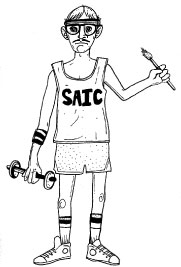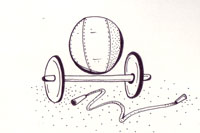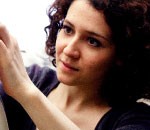Bringing fitness to an art school
By Britany Robinson
Illustrations by Colin Grimm
 The School of the Art Institute of Chicago is not your typical college. There are no varsity sports, no mascot, and no fight song. SAIC is on top of its game in the world of art schools, but when compared to traditional colleges and universities, there is one standard aspect of college living in which the School doesn’t strive to impress — fitness, a crucial component to the health of any college student.
The School of the Art Institute of Chicago is not your typical college. There are no varsity sports, no mascot, and no fight song. SAIC is on top of its game in the world of art schools, but when compared to traditional colleges and universities, there is one standard aspect of college living in which the School doesn’t strive to impress — fitness, a crucial component to the health of any college student.
The student population of SAIC has been slowly shifting as the school expands and attracts a more traditional student body. As the School’s leadership enters a transitional phase with the recent resignation of President Wellington “Duke” Reiter, it seems the perfect opportunity for this shift to be addressed and for the wants and needs of students to be acknowledged.
F Newsmagazine distributed a survey to 60 SAIC students in order to assess student interest in health and fitness at the school. The most telling statistics from this study show a shift in physical activity from high school to college.
Participants were asked how many hours a week they exercised, on average, before attending SAIC, and how many hours a week they exercise now. 72% of students responded that they exercised two to five times a week before attending SAIC. Now that they attend SAIC, 46% of students responded that they exercise two to five times a week.
Several factors affect this statistic. Students are more likely to compete in sports during high school than they are during college (especially in a college without a sports program), but there is also the reality that many students simply don’t have time to exercise when enrolled at such a demanding institution.
However, SAIC students are clearly interested in keeping fit, as 76% responded that they would make use of a campus gym if one were provided and 72% would make use of discounted membership to an area gym.
Throughout the Nation
Health and fitness are growing concerns outside of SAIC as well. First Lady Michelle Obama has made it her quest to tackle the issue of child obesity, and schools across the country are offering healthier options in their cafeterias while encouraging active lifestyles.
In response, websites such as Healthedpartners.org have recently been established to provide health service faculty tools and consultation services to improve upon current health and fitness habits of students.
Linda Pas, Director of Health Services at SAIC, recognizes the importance of this health movement in our country. “I finally feel like people are paying attention. Schools are getting rid of food that isn’t healthy for children. There is a movement, and if it doesn’t happen, children will not outlive their grandparents,” said Pas in an interview with F.
As popular as this topic seems to be, SAIC has held true to its offbeat tendencies by not joining the bandwagon on this movement, possibly to the detriment of its students. Students at SAIC are not provided with a meal plan or a full-service gym—two amenities that are given components of most school campuses, and important to students who are living away from home for the first time.
It may be unfair to compare fitness offerings at SAIC to other colleges and universities. Many schools have full-service gyms because they have NCAA sports teams that require these facilities (and often attract sponsors who fully equip these gyms with countless machines and pronounced branding).
If a school has teams that draw in spectators and, in turn, make money for the school, then it becomes more realistic to provide state-of-the-art equipment for athletes and the rest of the school to use. Let us, instead, compare SAIC to its urban art-centric neighbor — Columbia College.
Cross-Town Rivals
 Columbia College offers two separate gyms that are available to all students. Plymouth Court Fitness Center is open 24 hours a day to residents, but is also open to the rest of the student body from 11 a.m. -11 p.m., Monday through Friday; 11 a.m. – 5 p.m. on Saturday; and 5 a.m. – 11 p.m. on Sunday. Students also have access to the South Loop Elementary School gym, where Columbia College runs an intramural volleyball league and other club sports.
Columbia College offers two separate gyms that are available to all students. Plymouth Court Fitness Center is open 24 hours a day to residents, but is also open to the rest of the student body from 11 a.m. -11 p.m., Monday through Friday; 11 a.m. – 5 p.m. on Saturday; and 5 a.m. – 11 p.m. on Sunday. Students also have access to the South Loop Elementary School gym, where Columbia College runs an intramural volleyball league and other club sports.
The Renegades is the spirited school name given to the Fitness, Athletics and Recreation Student Association at Columbia. Their mission is to “develop the physical, social, organizational, emotional, and competitive skills of Columbia College’s students, necessary for the cultivation of a sound mind in a sound body.” Through this mission statement, the school addresses the comprehensive well-being of its students.
Bad At Sports is a popular Chicago art blog. Its title is clever, but is it telling? There exists a common assumption that the artsy kid in high school is reminiscent of MTV’s Daria standing in the backline of the volleyball court, holding out a limp arm in a feigned attempt to care about the game. There may a kernel of truth in this.
But students who enter an art school, SAIC or otherwise, are fundamentally no different from students beginning at large state universities or small liberal arts schools — they all require guidance in their first attempt at life as adults.
The Current State of Fitness at SAIC
The SAIC campus includes two residence halls. There is a modest-sized gym on the 4th floor of the 162 North State Street building for residents of either dorm to use, which includes several treadmills, ellipticals, stationary bikes, and weight machines. In order to use the gym, students must participate in a brief orientation on how to safely use the gym’s equipment.
According to Resident Assistant Christina Villa, the gym is nearly always in use and very popular among students that she oversees. Amongst participants in the F Newsmagazine Health and Fitness survey, approximately two-thirds utilize the equipment in the dorms.
Students do come to SAIC to become better artists, and undoubtedly, the school does a good job of fostering that. Pas, however, has seen a notable shift in the student body over the last fifteen years that she has held her position.
“It seems to me that when I started here, the students were more ‘artist type’ and not as interested in physical fitness. But that has changed. They’re coming right from high school now, and they’re involved in sports whether they’re artists or not,” Pas said.
She also expressed an interest in ensuring that SAIC Health Services acknowledges the whole-body wellness of the student. “We try to address self-care. We try to look at the whole student. When students come in to see us, we do a whole self-care check-list. Even if they come to discuss insurance, we go over all of that. The physical activity component is just evolving now.”
Five years ago, Health Services sent a survey to students via email entitled, “How the Health are You?” This survey, developed by the American College Health Association, was created between 1998 and 1999, and was distributed to over 900 institutions. Another survey of this kind has not been done since.
Pas fronted the distribution of the survey at SAIC. She noted that it was the first survey given to SAIC students that tried to understand the wellness of the student as a whole. Questions addressed topics from diet and exercise to sex and drug use.
One area that struck Pas when results were calculated was back pain — 55.9% of students reported regularly experiencing back pain. Pas remembered thinking to herself, “They’re so young for back pain!” She believes that the need to travel with equipment at SAIC — with most students lugging some kind of art supplies to class each day — contributes to this ailment, and that it is something that needs to be addressed. Despite these concerns, weight machines that work the lower back are still one of many components that are missing in the current dorm room gym.
Felice Dublon, Vice President and Dean of Student Affairs, mentioned to F that she also sees an interest in physical activity amongst students. “Artists are as interested in moving themselves as any other students,” she said. “There seems to be this myth that artists don’t, but they want to and we know that.”
When F spoke with Assistant Dean of Student Affairs Patrick Spence, he noted that the students’ interest in fitness has indeed grown in recent years, but is more for club sports than a full-service gym. Yoga, belly dancing and soccer are all student groups run through Student Activities and initiated by students who made the effort to get a group together and take action. “Students,” said Spence, “just never stop until they get it going.”
The yoga group is run by Nancy Desert Dragon Heraty on Friday afternoons. She focuses on the wellness of students and the benefits that movement — yoga in particular — can have on mind and body. Heraty believes that many students are missing the “mind, body and breath connection,” and she tries to help them establish that.
Heraty also emphasizes an increased awareness of posture and connection with one’s whole body on a level that allows recognition of anything abnormal or unhealthy. As an artist herself, Heraty believes that “the creative path connects to imagination and spiritual energy. The body needs to be strong and open so the path to creative exploration is clear.”
Moving Forward
 Spence’s position in Student Affairs and Campus Life puts him in the center of another reform that parallels the issues of health and fitness. Freshman orientation currently addresses stress management, and in doing so reinforces healthy eating habits and staying active to remain healthy in school.
Spence’s position in Student Affairs and Campus Life puts him in the center of another reform that parallels the issues of health and fitness. Freshman orientation currently addresses stress management, and in doing so reinforces healthy eating habits and staying active to remain healthy in school.
The information that is presented to incoming freshman is being entirely reworked this summer, and these issues will hold more weight than in previous years. “We’re looking at when we can talk to them about the importance of exercise and nutrition — how important these things are, especially when it gets colder and the term gets busier and things get more stressful,” said Spence of the changes that will be in effect for the incoming freshman of 2010.
The all-school meeting held on April 6 addressed seven strategic initiatives, the third of which was to develop a master campus plan. A student center on the first floor of the Sharp building is a part of this plan, and will include a cafeteria-style space that could potentially incorporate a meal plan for students.
Although students living in both dormitory buildings have access to full service kitchens, administration faculty are concerned that students are not eating healthy enough when faced with the task of learning to cook for themselves.
Unfortunately, as of now, there does not seem to be space for a full-service gym to be included in the plans for the future of our campus, unless of course students continue to express an interest in one. “Space is an issue with everything we do,” said Dublon. She feels that the “vertical” nature of SAIC’s campus frequently creates an obstacle to growth.
At one point in time, students were offered a discounted rate to Crunch Gym in the Loop, as an alternative to providing a campus gym. Crunch has since closed and another gym discount has yet to be arranged. Spence says the School is in the process of looking for one.
Another possibility that Dublon mentions is a multi-school gym — an idea that several developers have approached SAIC with. The plan would be to find a space in the loop to build a gym that would be accessible to several different schools.
Dublon says that idea is appealing to SAIC, but that other schools have failed to show similar interest — likely because other area schools, including Columbia College, DePaul University, and Roosevelt University, all have their own full-service gyms that are open to their entire student body.
Dublon, Spence, and Pas all expressed an interest in hearing more from students. They invited F Newsmagazine to continue this conversation with them in the coming months, as plans progress and unfold for the student center and other school improvements.
SAIC’s administration has multiple issues on their problem-solving plate right now, and their openness to address the concerns of all in the SAIC community allows the School to evolve in a favorable direction.
Health and fitness, if not on the top of the list, are fortunately being included in the effort to improve the experience of the student body, and eventually this global, national and localized movement will benefit us all.























Hello,
This article was a disappointing fact facing SAIC incoming students. I’m surprised that a college known for innovation would be years behind on the core of healthy living. My daughter is seriously interested in applying to SAIC in the near future. It is my hope that this issue will be addressed and a solution forthcoming.
J Rosenstein LSW Teen Therapist